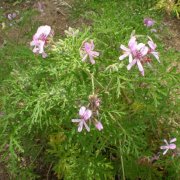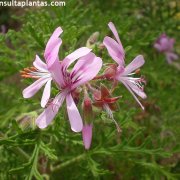Care of the plant Pelargonium radens or Rasp-leaved pelargonium |
|
The genus Pelargonium, family Geraniaceae, comprises 200 species of herbaceous plants, succulents and shrubs native to southern Africa. Some species are: Pelargonium radens, Pelargonium quercifolium, Pelargonium peltatum, Pelargonium odoratissimum, Pelargonium graveolens, Pelargonium grandiflorum, Pelargonium exstipulatum, Pelargonium cucullatum, Pelargonium crispum, Pelargonium zonale, Pelargonium tetragonum, Pelargonium magenteum, Pelargonium capitatum. Common names: Rasp-leaved pelargonium, Multifid-leaved pelargonium. This species is native to the southern and eastern Cape, South Africa. They are fast-growing perennials that reach 1.5 meters (4.92 feet) in height. The leaves, aromatic when pressed, are divided into fine serrated lobes of deep green color. The flowers are pale pink or purple. They bloom from early spring to early fall. Rasp-leaved pelargonium is used in borders, in solid beds and in pots and planters for terraces, patios, windows and balconies. Pelargonium radens prefer full sun exposure; in semi-shade they bloom less. It resists occasional frosts down to -3 ºC (26.6 ºF). It's important that the soil is not calcareous; use a mixture of coarse sand, forest soil and clay. Transplant every year in early spring. Water daily in summer and every 3 days in spring; they resist several days of drought. The rest of the year water moderately waiting for the substrate to dry. Fertilize with manure or compost in late winter or early spring. Prune lightly in fall when flowering is complete. Pelargonium radens is a resistant plant to the usual pests and diseases. Rasp-leaved pelargonium is propagated from seeds sown in the fall or by cuttings set to root in a sandy substrate in spring, summer or fall. |
Images of the plant Pelargonium radens or Rasp-leaved pelargonium |
Find plants
Pelargonium radens or Rasp-leaved pelargonium | Care and Growing
© 2025 FavThemes

